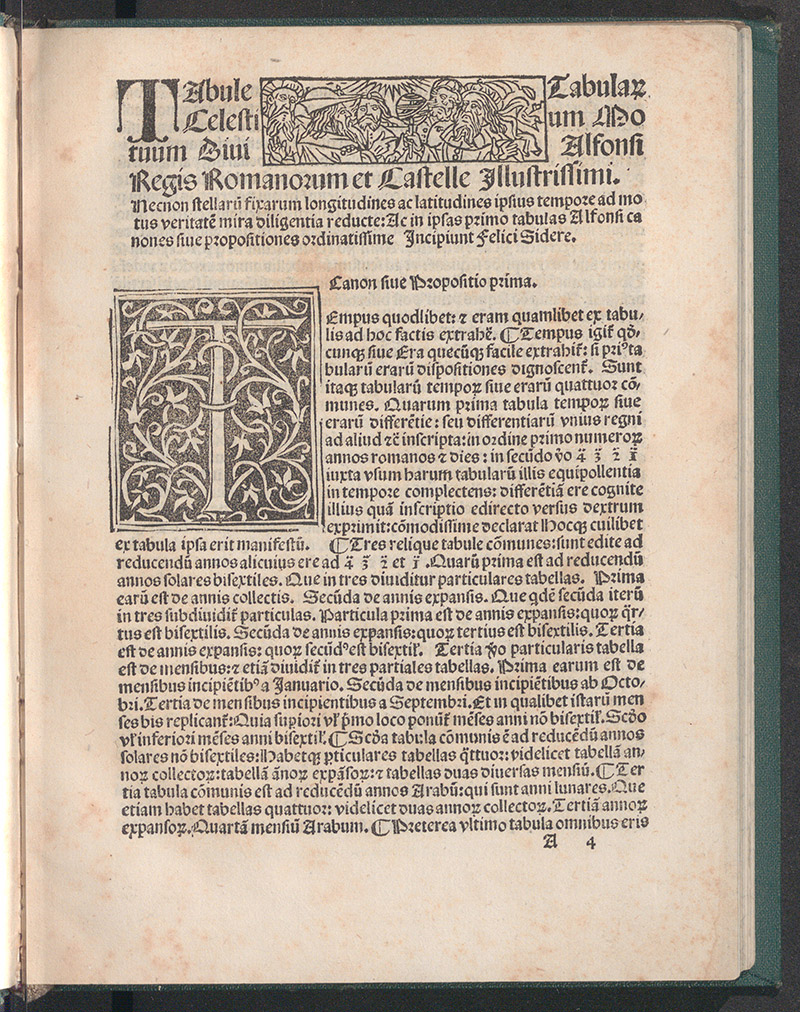Alphonsine Tables

- Beginning of the text of the Alphonsine Tables. Fol. A4v.
- Alphonsus, Rex Castellae (1221-1284).
- Tabulae astronomicae. Ed: Johannes Lucilius Santritter. With additions by Augustinus Moravus. Add: Johannes Lucilius Santritter: Canones in tabulas Alphonsi.
- Venice: Johannes Hamman, 31 Ot. 1492.
Astronomical tables were designed to predict the positions of planets, lunar phases, eclipses, the times of the setting and rising of the sun, and the conjunctions of celestial bodies. Additionally, these tables were employed for astrological purposes and calendrical computations, including the advanced calculation of important dates of both Muslim and Christian calendars. In the Islamic world a good example of a handbook of astronomical tables is al-Zij al-Hakimi al-kabir by the tenth-century Egyptian mathematician Ibn Yunus. In the second half of the eleventh century, Muslim astronomers in Toledo compiled the Toledan Tables, which were based on the corrections that one of these astronomers, al-Zarqālī, made to Ptolemy’s Handy Tables.
In the thirteenth century, King Alfonso X of Castile, popularly known as Alfonso the Wise, commissioned an update of the Toledan Tables, whose text is known as the Alphonsine Canons: they were written in the vernacular Castilian under the direction of the Jewish scholars Jehuda ben Moses Cohen and Isaac ben Sid around 1272. Specifically, the Alphonsine Canons survive in the form of instructions explaining tables that are now lost. Unfortunately, this work was little known until a Latin version was prepared in Paris around 1320, the Tables of Paris, which included charts with Arabic numerals and Latin headings, being eventually supplemented with instructions by various fourteenth-century astronomers such as Jean de Murs, Jean-de-Linières, and John of Saxony. Though it is difficult to establish the exact relationship between the Alphonsine Canons and the Tables of Paris, the improved Latin version became known as the Alphonsine Tables, whose text was the basis for the first printed editions, including the editio princeps of 1483 and the one shown here, our copy of the third edition published in 1492. Through subsequent printed editions, the text of the Alphonsine Tables became a point of reference for astronomers, who again gradually edited and modified these tables until they became obsolete. For instance, we know that Nicolaus Copernicus owned a Sammelband (various separately printed works bound together) that included a copy of the second edition of the Alphonsine Tables (Venice, 1485) along with the first edition of Johannes Regiomontanus’Tabulae Directionum (Augsburg, 1490).
Select Bibliography
- Chabás, José. 2019. Computational Astronomy in the Middle Ages: Sets of Astronomical Tables in Latin. Estudios sobre la Ciencia 72. Madrid: Consejo Superior de Investigaciones Científicas.
- Gingerich, Owen. 1987. “The Alphonsine Tables in the Age of Printing.” In De astronomia Alphonsi regis:actas del simposio sobre astronomía alfonsí celebrado en Berkeley (agosto 1985) y otros trabajos sobre el mismo tema, edited by Merce Comes, Roser Puig, and Julio Samso. Barcelona: Universidad de Barcelona: 89-95.